(Cervus elaphus) ELK, WAPITI, or RED DEER
Size of Jasper Alberta's Elk
- Mass: 230 to 450 kg
Length: to 10 ft. (3 m) - Wildlife living area: taiga, temperate forest & rainforest, temperate grassland
Status: no special status.
Range: Although elk were once found throughout much of the Northern Hemisphere, today large populations are found only in the western United States from Canada through the Eastern Rockies to New Mexico, and in a small region of the northern lower peninsula of Michigan. Elk were reestablished in the eastern United States with three transplantations throughout the 1900's. Various elk populations in the western US, including Yellowstone National Park in Wyoming, contributed to the reestablishment. - Elks range in color from dark brown in winter to tan in summer and have a characteristic buff colored rump. The head, neck, belly and legs are darker than both the back and sides. Elk generally have a long head with large ears and widely branching antlers as long as 1.1-1.5 m from tip to tip.
- A dark shaggy mane hangs from the neck to the chest. With a thick body, short tail and long slender legs, most elk stand approximately 0.75-1.5 m high at the shoulder and are 1.6-2.7 m from nose to tail. Most males are 10 percent larger than females and weigh twice as much.
- Most Elk Bulls shed their antlers during late March or very early April. At this time, their testosterone levels are generally considered to be at their lowest. The low testosterone levels contribute to the bone connected to the base of the antlers deterioration and eventually fall off.
Jasper Elk Rut with Lots of Bugling and Aggressive Bull Guarding Harem..
The Elk Rut
Big Elk Bulls Anxious to Shed their Antlers
Big Elk Bulls Anxious to Shed their Antlers and start re-growth right away for the next Elk Rutting Season. This is the time of year that the larger Bulls begin shedding their antlers. Younger Elk Bulls may shed their months from now.
Elk Herd Traversing Athabasca River in Front of Beautiful Mountain Range
Elk herd traverses Athabasca River in front of a Beautiful Mountain range containing Mount Edith Cavell and Whistlers Mountain. This is near the end of the Elk Rut and this herd was moving on this day without a dominant Elk Bull. In these cases it is usually a Matriarch Elk Cow that leads the herd.
Biggest Elk Bull Starts to Form His Harem.. The "Sheriff"
This Well-Known Elk Bull has been named the "Sheriff" in this area of the Canadian Rockies as his tenacity and aggression during the Rut has been unmatched for years. He lost a very long battle at the end of the Elk Rut last year to a younger rival(after fighting many), but came back and re-claimed his position just a few days later in 2019. Here he is Today, in a more secluded territory, likely knowing that age is catching up with him. We hope he stays here to avoid the competitiveness of a prime Elk location, also among people and traffic that often shortens the lives of Elk who stay there. His Offspring will be amazing. His Bugles draw Cows in from miles around. We are looking forward to seeing his Harem grow fast over the "Rut's" next several weeks.
The Calm Before the Storm
A Magnificent Bull Today.. He was one of the most active and dominant bulls during the Elk Rut last year and it looks like he will be topping his form this year. It is fantastic to be able to witness these Athletes in their prime. This Elk Bull will be shedding his velvet in about 1 month. He was one of the first to shed last year.
Why Do Elk Eat Bark? The Most Battled and Dominant Elk Bull in the Off Season.
Green-like bark from the pigment of green chlorophyll is a source of nourishment for elk, especially in the winter when other green plants have lost their greenery and nourishment. Here, the Most Battled and Dominant Elk Bull(the Sheriff) is seen eating green bark in the off Season when other greens are not available. This Amazing Bull is all of the Largest, Most Dominant, and Oldest Elk Bull in this large wild area. It is always a great day when we come across the "Sheriff!"
Newborn Elk Baby Walking and Nursing
The first sighting of a newborn Elk baby as it becomes more mobile and nurses.
The Sheriff Goes for a Swim to Cool Off
The Largest Elk Bull in this area, the "Sheriff" took a Swim today to Cool Off in front of a Beautiful Canadian Rocky Mountain Background during the Rut.
The Most Successful and Battled Elk Bull in this Territory
Here are some highlights of the last several years of this areas most famous Elk Bull during the rutting season. He has dominated this area for many years now and while his behavior was more cautious in 2020, his maturity served him well. Just a few days ago, we captured him looking the best he has ever looked at this time of year.. not a broken tine and a strong, healthy gate. The "Sheriff", as many call him now, has proved to be an incredible being with exceptional genetics!
Elk Bull After Shedding One Antler
We were lucky to catch an Elk Bull After Shedding One Antler. You can see he feels a little bit odd with one antler gone. Usually, they will shed the other antler within 24 hours and by the looks of the fresh wound, it had sealed up and healed somewhat, so it was worth observing for a bit. The antler still in tact did not show any separation yet, as you can see. We were not lucky enough to catch the other antler dropping before all of the Elk Bulls became startled by something in the bush and moved on. The Sheriff and some of the other Dominant Elk Bulls were bedded down in the forest near by.
Battle Between Two Elk Bull Giants
Some Rare luck offered witness to two well-known Elk Bull Giants doing Battle today during the Rut. The current Palisades King of this area's Harem was defeated by the Talbot King here Tonight. Sorry for the shakiness.. the camera had to be held over our head to capture these awesome moments as best we could in a very tricky situation.
Largest Bull herding His Harem During the Elk Rut
The Biggest Elk Bull in this area that many call the "Sheriff" has been much less confrontational with other Bulls and much more focused on herding His Harem this Year. We have witnessed days when there were as many as 7 other Big Bulls circling Him and his Harem(will share shortly), but the Sheriff remained focused on the Cows rather than challenging other Bulls this Year. Last Year, He was chasing every Bull that came close, but this Year, it is very noticeable that He has become much more calculating on the risks involved in spending extra energy. It has also been observed that other Bulls have not entered his immediate domain, showing respect for this Amazing Bull's Power during this Year's Elk Rut. This is definitely "learned behavior" that we find quite impressive in Mature Elk Bulls. Many are Cheering Him on in Canada's Rockies, and the Sheriff has not disappointed with teaching us even more this Year!
First Dominant Elk Bull Moving in to Own His Rutting Territory
This Dominant Elk Bull was the satellite Bull that was run off in the beginning of our most viewed Elk Rut video back in 2018. Last Year(2020), he began ruling that same territory with his incredibly gifted energy and stamina. This Year, we were lucky to capture him as he arrives to rule the same area once again, looking magnificent!
First Elk Bull to Form Herd in the Elk Rut
The first big Elk Bull to form a herd with his cows and calves is already very active early in the Elk Rut.
Huge Elk Bull Eats Pine Needles when Food is Scarce
The Sheriff, this areas largest and most dominant Elk Bull, looks to eating pine needles at times in the winter. When snow on the ground covers forage and extreme cold stresses Elk, they may turn to pine needles for food. Pine needles are not highly nutritious food and are loaded with resin acids that make them a little distasteful. During cold snaps or times of heavy snow however, pine needles can comprise as much as half an Elk's diet. Female animals such as elk, bighorn sheep, mule deer and whitetail deer can eat pine needles in late pregnancy with no ill effect, but early pregnancy can witness issues. Elk are known to snap branches off trees and shrubs to feed when they need to. Pine needles are high in vitamin C and actually can help alleviate congestion and other respiratory problems.
Young Elk Bull Ramping Up around Cows
This is the First Elk Bull in the beginning of the Elk Rut that we have witnessed showing true "Elk Rut" behavior. While his Antlers are not very big yet(this year), he has a comparatively big body that will command respect whenever push comes to shove. Usually only the largest of Bulls have fully shed their velvet by now, but he is demonstrating that he wants in on that early advantage now. His confidence is showing and we were glad to be there!
Very Active Elk Bull with His Harem During the Elk Rut
A Magnificent Elk Bull being very active during the Rut in the Canadian Rockies. This Elk rut video is part 2 of 2 of this Bull and his harem as aggression and herding instincts are very high.
Talbot Titan Announces His Arrival During the Elk Rut
After travelling about 40km and defeating every other Elk Bull in his path(we shared the battle with the Palisades King), this Talbot Titan has now entered the most competitive territory during the Rut. There were 3 Bulls within hundreds of meters of him here all Bugling tonight.. his presence already removed one in a short face-off. This Elk Bull may now rival the well-known "Sheriff" in muscle mass, of which currently rules this territory. We expect these Magnificent Giants will meet very shortly, and we hope we are lucky enough to be there when that happens!
Bull Behaviors with His Harem During the Elk Rut
Here is one of several successful Bulls in the Canadian Rockies during this year's Elk Rut the last few weeks, displaying..
- Vocalizations,
- Rubbing antlers against trees, shrubs and the ground to impress cows, show dominance, and mark a territory,
- Licking, Sniffing and tasting,
- Flehmen or lip curls,
and Herding his Harem.
Vocal Elk Bulls Sparring After the Rut
Even in the end of January, these energetic Elk Bulls may break out into sparring or play to practice and grow for the next rutting season. Here is a good example of their vocalizations during these workouts that are usually louder during play than an all out fight. We observed many Elk Bulls today and it was very pleasing to see all of them look so healthy this time of year.
Newborn Elk Calves First Few Months in Canada's Rockies
Elk Females or Cows usually give birth to their calves or baby elk late May through early June. Elk Calves weigh between 30 and 35 pounds and gain around 2 pounds per day in their first few months. Most cows give birth to one calf, but occasionally they will give birth to two calves. Elk Cows leave the herd to give birth to her babies in isolated areas. Like deer, elk calves are born spotted and scentless. These adaptations help camouflage the calf as it lies motionless in it's surroundings. Predators actively search for newborns in early Summer, so Mothers often move away to keep attention away from any activity near a calf. Elk calves usually lose their spots by September, at the same time the Elk Rut begins. Calves will nurse from their mothers typically for up to five months, and can start eating grass younger than one month old. The Calf usually rejoins the herd with their Mother after about two weeks. Like all intelligent species, it does not take them long to discover "Play" shortly after joining the herd!
Elk with Newborn Calf by Athabasca River
A newborn elk calf can stand after the first 20 minutes of life, but it can not run fast or for long periods of time. At birth, an elk calf weighs about 35 pounds, gaining up to two pounds a day for the first few weeks. Mother elk can weigh more than 500 pounds. A newborn Elk calf's fur is dotted with cream-colored spots. For the first few weeks, the mother Elk will usually hide her calf in thick brush and graze at a distance so she won't draw attention to its presence. In this instance, this mother Elk has had her calf on the safety on a very small island on Athabasca River. As seen here, she chooses to use the Athabsaca River to her advantage as she pretends to cross, but actually does a semi-circle, staying nearby to protect her calf if need be.
Newborn Elk Calf following Mum to Safety
Our first sighting of a newborn elk calf following Mum to safety this year. Like deer, newborn Elk Calves are spotted and have no scent. Elk calves will lie motionless in the grass for safety, and are very difficult to see when doing so often even in open areas. Elk calves usually lose their spots by September. Elk calves typically are ready to rejoin the herd with their mother after two weeks. At about six months, a young elk calf will be about the size of a full-grown Whitetail deer.
Elk Bulls sharing Territory during the Rut have an Eruption
Elk Bugles and Chuckles from Early Rutting Season
Here are some Elk Bugles and Chuckles from this year's largest Bulls in early rutting season so far.
Ready for the Elk Rut - 1 Week Transformation..
One of the Largest Elk Bulls in the Canadian Rockies Before and After Fully shedding his Velvet. Just one week later his antlers are dry and he is ready for the Rut. Larger, more mature Elk Bulls shed first as their testosterone rises, giving them an advantage on establishing continued dominance early in the Rutting Season.
First Big Elk Bull Forming His Harem - The Rut has Begun!
This Big Elk Bull has come down from the Valley to form his Harem in a very competitive Elk Rutting location. This Bull is certainly one of the largest seen so far this year, but he will likely have to face some incredible challengers over the next few weeks, as more large Elk Bulls come out to compete in the Rut. The Elk Rut has Begun!
Elk Sparring after the Rutting Season - Males form bachelor groups that stay together through the cold Canadian winter months..
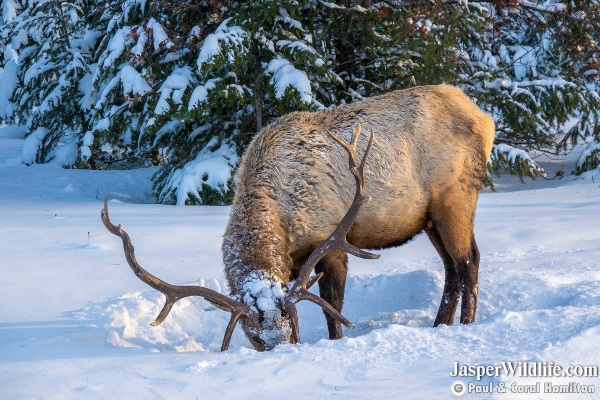
Where do Elk(Wapiti) live?

Newborn Elk Calf in Jasper - 2019
Older, Bigger Elk Bulls shed their Antlers first, grow first, and polish the velvet first. It's nature's way of allowing the most mature bulls an advantage when entering the Rutting Season. With Rutting season quite a distance from late June yet, this Bull prefers isolated areas with lots of food to pack on as much mass as possible right now. Elk Calves show strong agility and energy by the end of June.
He Lives! "The Sheriff" in Full Velvet Today
Here is this area's largest and most dominant Bull(the last 5 Years), in full velvet today. We have not previously captured any moments of the "Sheriff" at this stage, as he packs on more weight just before the Elk rut. Wolves managed to bring down a very big Elk Bull not that long ago and we were worried it might have been the "Sheriff", but are so glad to see him here today! Everyone will be Cheering you on again this Year Big Guy.
Bigger Bull Steals the Herd Early in the Elk Rut
A bigger Elk Bull came in and stole the herd from the First Bull that formed this herd. The fight must have been just an hour or so before we observed this new slightly larger bull being very active in his takeover. There were still some cows scattered, but he gradually brought them all together with lots of bugling and herding behavior. It was a perfect cool evening to catch those steamy Elk Bugles.
Three Bull Elk in Jasper's beautiful, lush Rocky Mountains in July
Elk in Jasper, Canada's Rockies in June
Jasper, Alberta's Largest Bull Elk Seen So Far in 2019 as his Testosterone level Rises into the Rutting Season..
Details on Elk in Jasper
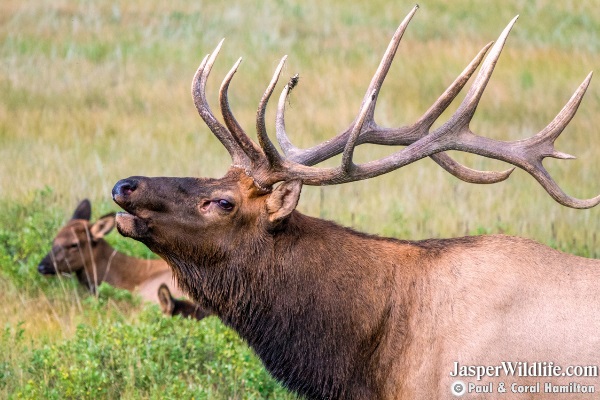
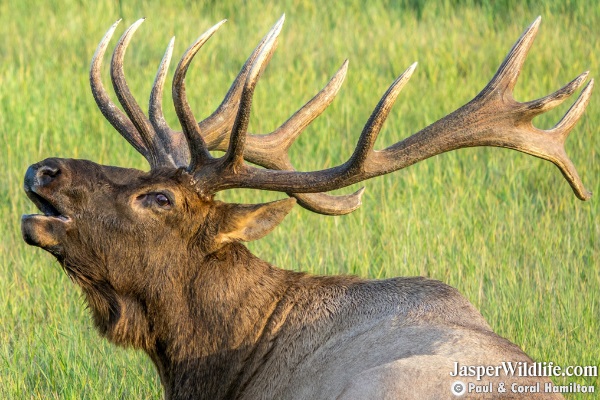
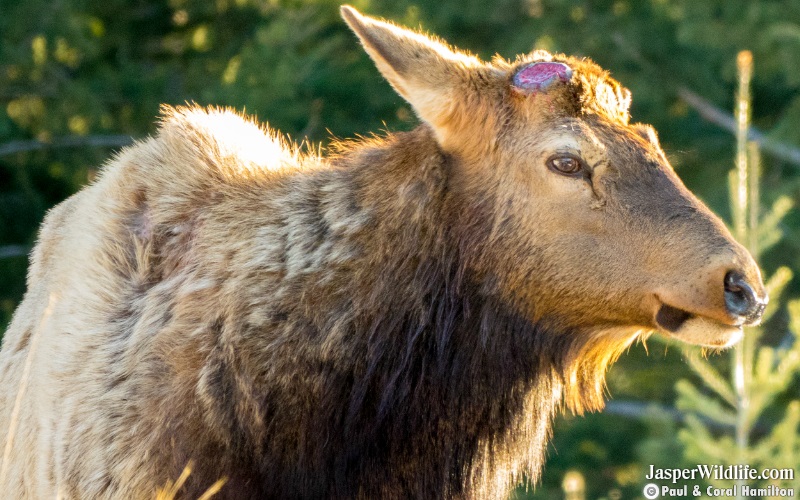
2019 March - One of Jasper's Largest Elk Bulls the Day of Dropping His Antlers
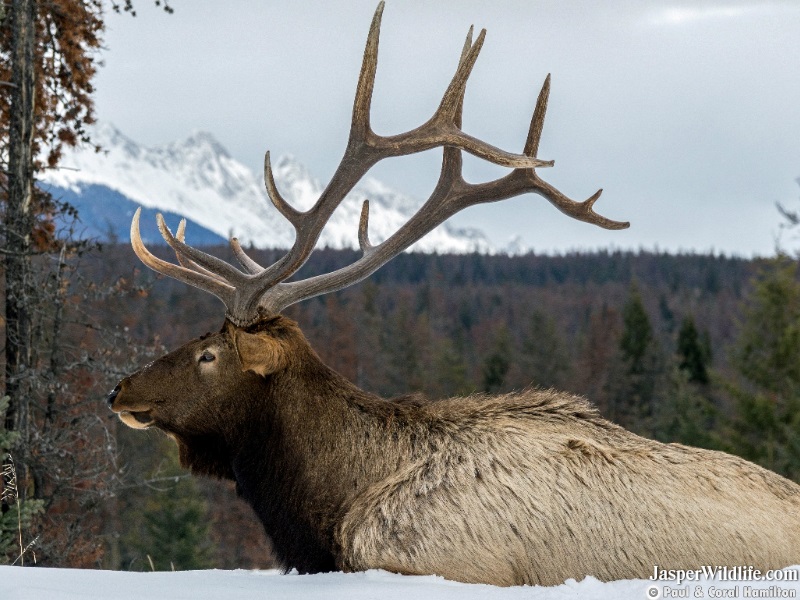
Mature Elk Bull resting in Jasper, March 2020

August Bull Elk in full Velvet, just days Before beginning to shed this velvet.
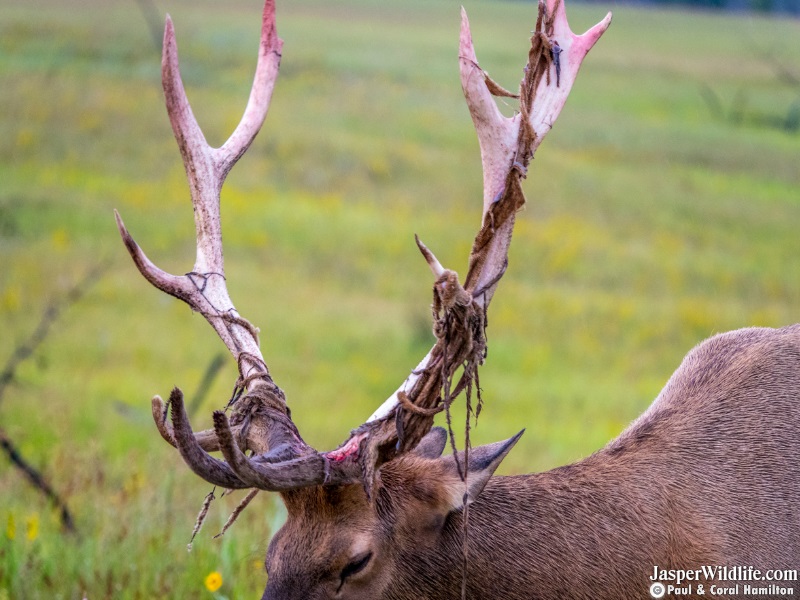
August Bull Elk shedding his velvet. This Bull's antlers will dry and harden very quickly, allowing this fairly large Bull to possess an advantage over other Bulls not yet shedding their velvet.
One of the Most Impressive Bull Elks in JNP. Video is from the day of dropping his antlers. Bigger Bulls seem to do this earlier, getting a head start towards more mass the following year. This King still Asserts his dominance without His Crown... defending his spaces even at His lowest testosterone levels.
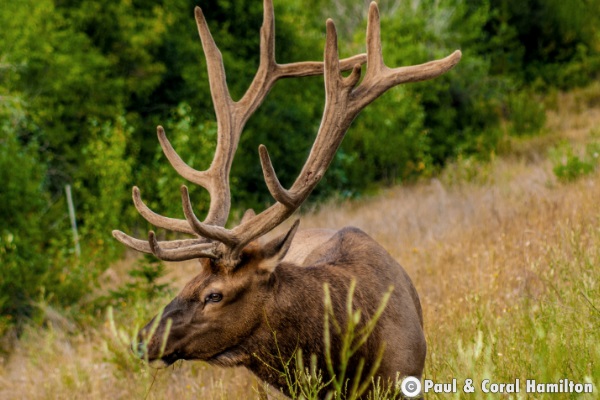
A Beautiful Canadian Rockies Retreat, Lake Annette and surroundings hosted this incredible Bull and Cows on this day during the Elk Rut..
Elk Bull Aggression Rising for the Rut
Each day now there is more chasing, more herding and eventually more battling, as Elk Bull aggression rises during the early stages of the Rutting Season. It will usually take several cool days in a row before Elk Cows start entering Estrus, however.
Elk prefer open woodlands and avoid dense unbroken forests. Elk can be found in coniferous swamps, clear cuts, aspen-hardwood forests, and coniferous-hardwood forests.
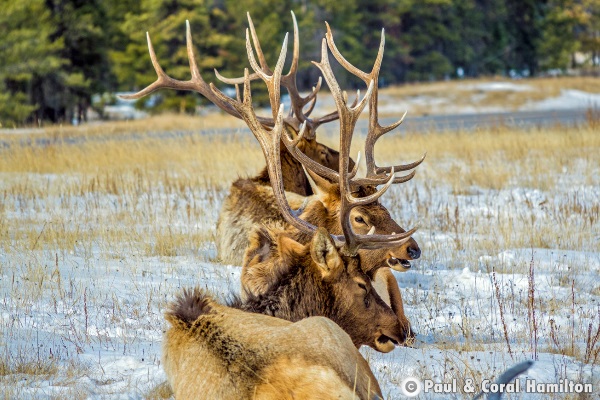
Elk have a home range of approximately 600 square miles.
Elk tracks are 3.5 - 4.5 in. (9 - 11 cm.) long and less pointed that the similarly-sized moose's. Dew claws are evident in snow, mud, and when running.

Elk Tracks
